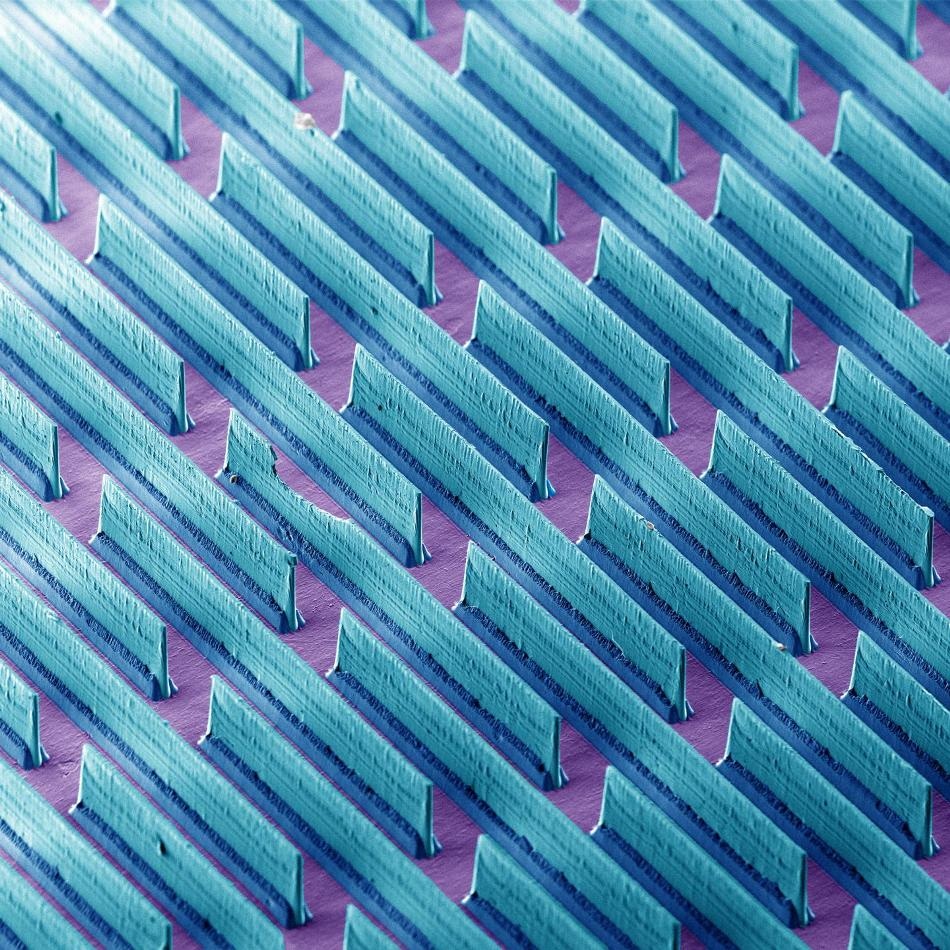Dec 13 2017
For a long time, scientists have been fascinated by a gecko scampering up a wall or across a ceiling, and this has indeed encouraged the scientists to examine how to harness a lizard's mysterious potential to defy gravity.
 This is a microscopic image showing the walls formed to mimic the adhesion characteristics of gecko feet. CREDIT Georgia Tech
This is a microscopic image showing the walls formed to mimic the adhesion characteristics of gecko feet. CREDIT Georgia Tech
The development of human-made devices inspired by gecko feet, in recent years, have helped their wearers to slowly scale a glass wall, the promising applications of gecko-adhesion technology go much beyond Spiderman-esque antics.
A researcher from the Georgia Institute of Technology is currently analyzing how the technology could be employed in a high-precision industrial setting, such as in robot arms utilized for manufacturing computer chips.
There are numerous ways that gecko adhesion could be used in an industrial setting, especially in handling delicate materials like the silicon wafers used in manufacturing computer processors.
Michael Varenberg, Assistant Professor, George W. Woodruff School of Mechanical Engineering, Georgia Tech
However, before robot arms and various other devices can apply gecko adhesion technology, researchers will require more information about the physical and mechanical characteristics of the human-made adhesive surfaces.
In a study featured in the December 13th issue of the Journal of the Royal Society Interface, Varenberg focused on a specific type of gecko-inspired adhesive surface and then narrowed down a variety of angles at which the material will fasten stronger and then release its grip in a much simpler manner.
The gecko acquires its unique potential by using small hairs capable of interacting with surfaces at an intermolecular level. It is a one-two process during which the small film-like hairs are pressed onto the surface and made to engage with a shearing action. Following this, the hairs either hold to the surface or effortlessly release when they are pulled away at varied directions.
In order to replicate this process in a factory by using man-made adhesive technology, it is essential for the researchers to determine the exact angles at which to apply a load to release or to get the grip between the silicon wafer and the robotic arm.
Varenberg's team tested a wall-shaped microstructure surface, molded out of polyvinylsiloxane and designed for mimicking the gecko's attachment skill. Their tests demonstrated that the optimum attachment angle differs between 60 and 90 degrees, while the microstructure detach at zero force when the pull-off angle touches 140-160 degrees.
That relatively wide range to control the attachment and pulling away for these wall-shaped microstructures will make it easier to build a mechanical process around that tolerance.
Michael Varenberg
This indeed could prove to be promising for replacing a present method employed during the processing and inspection of silicon wafers in computer processor production. Robot arms use ceramic chucks that in turn use electrostatic grippers or vacuum in order to pick up and handle the wafers. Immediately after installation, the ceramic contact posts start to wear down because of cyclic loading and then release particles capable of potentially contaminating the backside of the wafer resulting in lithography defects on its front side.
This reality is inconsistent with the cleanliness standards required in the semiconductor industry. Using gecko adhesion microstructures instead would be better because they do not generate any damage to wafers and do not wear over time.
Michael Varenberg
According to Varenberg, subsequent steps in the research include simplifying the manufacturing technique, followed by working with industrial-grade materials and also analyzing the effects of surface geometry parameters and environment.